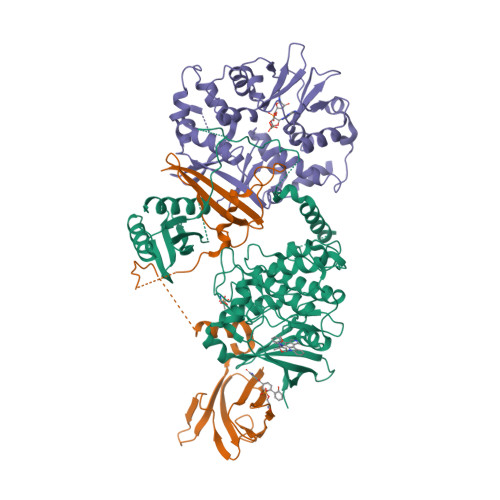GtoPdb is requesting financial support from commercial users. Please see our sustainability page for more information.
Contents:
Previous and Unofficial Names  |
| AMP-activated protein kinase |
Database Links  |
|
| BRENDA | 2.7.11.1 |
| KEGG Enzyme | 2.7.11.1 |
Selected 3D Structures  |
|||||||||||||

|
|
||||||||||||
Enzyme Reaction  |
||||
|
||||
Download all structure-activity data for this target as a CSV file 
| Activators | |||||||||||||||||||||||||||||||||||||||||||||||||||||||||||||||||||||||||||||||||||||||||||||||||||||||||||||||||||||||||||||||||||||||||||||||||||||||||||||||||||||||||||||||||||
| Key to terms and symbols | View all chemical structures | Click column headers to sort | |||||||||||||||||||||||||||||||||||||||||||||||||||||||||||||||||||||||||||||||||||||||||||||||||||||||||||||||||||||||||||||||||||||||||||||||||||||||||||||||||||||||||||||||||
|
|||||||||||||||||||||||||||||||||||||||||||||||||||||||||||||||||||||||||||||||||||||||||||||||||||||||||||||||||||||||||||||||||||||||||||||||||||||||||||||||||||||||||||||||||||
| View species-specific activator tables | |||||||||||||||||||||||||||||||||||||||||||||||||||||||||||||||||||||||||||||||||||||||||||||||||||||||||||||||||||||||||||||||||||||||||||||||||||||||||||||||||||||||||||||||||||
| Activator Comments | |||||||||||||||||||||||||||||||||||||||||||||||||||||||||||||||||||||||||||||||||||||||||||||||||||||||||||||||||||||||||||||||||||||||||||||||||||||||||||||||||||||||||||||||||||
| Poxel have an AMPK activator known as PXL770 (structure not disclosed) that is under clinical evaluation as a treatment for nonalcoholic steatohepatitis (NASH; see Ph2 study NCT03763877). The mechanistic rationale is that activation of AMPK will modulate several metabolic pathways, including lipid metabolism, glucose control and inflammation, and thus provide relief from the pathological effects that arise in NASH. | |||||||||||||||||||||||||||||||||||||||||||||||||||||||||||||||||||||||||||||||||||||||||||||||||||||||||||||||||||||||||||||||||||||||||||||||||||||||||||||||||||||||||||||||||||
| Inhibitors | |||||||||||||||||||||||||||||||||||||||||||||||||||||||||||||||||||||||||||||||||||||||||||||||||||||||||||||||||||
| Key to terms and symbols | View all chemical structures | Click column headers to sort | |||||||||||||||||||||||||||||||||||||||||||||||||||||||||||||||||||||||||||||||||||||||||||||||||||||||||||||||||
|
|||||||||||||||||||||||||||||||||||||||||||||||||||||||||||||||||||||||||||||||||||||||||||||||||||||||||||||||||||
| General Comments |
|
AMP-activated protein kinase (AMPK) is a heterotrimeric protein kinase, made up of one catalytic α subunit, one β and one γ subunit, both of which are regulatory in function. AMPK is a regulator of energy balance at the cellular and whole body levels. AMP binds to "Bateman domains" on the γ subunit and this promotes activation via increased phosphorylation of Thr172 on the activation loop of AMPK's α subunit. Characterization of functional, full-length, muscle-specific α2β2γ3 AMPK produced in E. coli has been reported [8]. AMPK was originally recognised as a regulator of energy and metabolic balance and was proposed as a promising target for drugs aimed at treatment of type 2 diabetes and the metabolic syndrome. It has subsequently been ascribed roles in additional biological processes. For example, AMPK is now considered as a driver of autophagy, a process that is very important for maintaining proper cell function. The autophagic system degrades unwanted or damaging cellular contents including long-lived proteins, protein complexes, damaged organelles and invading pathogens. Dysregulated/ineffective autophagy is recognised as being associated with a variety of diseases including cancer, viral and bacterial infections, and neurodegeneration. In neurodegenerative conditions that are characterised by the formation of protein aggregates (tauopathies, Huntington disease, Alzheimer's), autophagic function is considered to be key for effective depletion of the aberrant proteins whose accumulation proves to be toxic to cells. Thus, drug-like AMPK activators are being investigated as a mechanism to elevate autophagy-driven clearance of the protein aggregates associated with neurodegenerative diseases [11], as an alternative mechanism to mTOR inhibition [9-10]. |
References
1. Aspnes GA, Butler CR, Calabrese MFP, Cameron KO, Curto JM, Green ME, Hou X, Liu S, McClendon CL, Murray JC et al.. (2024) Compounds for the activation of ampk. Patent number: WO2024084390A1. Assignee: Pfizer Inc.. Priority date: 17/10/2023. Publication date: 25/04/2024.
2. Coffey G, Betz A, DeGuzman F, Pak Y, Inagaki M, Baker DC, Hollenbach SJ, Pandey A, Sinha U. (2014) The novel kinase inhibitor PRT062070 (Cerdulatinib) demonstrates efficacy in models of autoimmunity and B-cell cancer. J Pharmacol Exp Ther, 351 (3): 538-48. [PMID:25253883]
3. Cool B, Zinker B, Chiou W, Kifle L, Cao N, Perham M, Dickinson R, Adler A, Gagne G, Iyengar R et al.. (2006) Identification and characterization of a small molecule AMPK activator that treats key components of type 2 diabetes and the metabolic syndrome. Cell Metab, 3 (6): 403-16. [PMID:16753576]
4. Corton JM, Gillespie JG, Hawley SA, Hardie DG. (1995) 5-aminoimidazole-4-carboxamide ribonucleoside. A specific method for activating AMP-activated protein kinase in intact cells?. Eur J Biochem, 229 (2): 558-65. [PMID:7744080]
5. Engers DW, Frist AY, Lindsley CW, Hong CC, Hopkins CR. (2013) Synthesis and structure-activity relationships of a novel and selective bone morphogenetic protein receptor (BMP) inhibitor derived from the pyrazolo[1.5-a]pyrimidine scaffold of dorsomorphin: the discovery of ML347 as an ALK2 versus ALK3 selective MLPCN probe. Bioorg Med Chem Lett, 23 (11): 3248-52. [PMID:23639540]
6. Göransson O, McBride A, Hawley SA, Ross FA, Shpiro N, Foretz M, Viollet B, Hardie DG, Sakamoto K. (2007) Mechanism of action of A-769662, a valuable tool for activation of AMP-activated protein kinase. J Biol Chem, 282 (45): 32549-60. [PMID:17855357]
7. Machrouhi F, Ouhamou N, Laderoute K, Calaoagan J, Bukhtiyarova M, Ehrlich PJ, Klon AE. (2010) The rational design of a novel potent analogue of the 5'-AMP-activated protein kinase inhibitor compound C with improved selectivity and cellular activity. Bioorg Med Chem Lett, 20 (22): 6394-9. [PMID:20932747]
8. Rajamohan F, Harris MS, Frisbie RK, Hoth LR, Geoghegan KF, Valentine JJ, Reyes AR, Landro JA, Qiu X, Kurumbail RG. (2010) Escherichia coli expression, purification and characterization of functional full-length recombinant alpha2beta2gamma3 heterotrimeric complex of human AMP-activated protein kinase. Protein Expr Purif, 73 (2): 189-97. [PMID:20451617]
9. Ravikumar B, Vacher C, Berger Z, Davies JE, Luo S, Oroz LG, Scaravilli F, Easton DF, Duden R, O'Kane CJ et al.. (2004) Inhibition of mTOR induces autophagy and reduces toxicity of polyglutamine expansions in fly and mouse models of Huntington disease. Nat Genet, 36 (6): 585-95. [PMID:15146184]
10. Sarkar S, Krishna G, Imarisio S, Saiki S, O'Kane CJ, Rubinsztein DC. (2008) A rational mechanism for combination treatment of Huntington's disease using lithium and rapamycin. Hum Mol Genet, 17 (2): 170-8. [PMID:17921520]
11. Walter C, Clemens LE, Müller AJ, Fallier-Becker P, Proikas-Cezanne T, Riess O, Metzger S, Nguyen HP. (2016) Activation of AMPK-induced autophagy ameliorates Huntington disease pathology in vitro. Neuropharmacology, 108: 24-38. [PMID:27133377]
12. Xiao B, Sanders MJ, Carmena D, Bright NJ, Haire LF, Underwood E, Patel BR, Heath RB, Walker PA, Hallen S et al.. (2013) Structural basis of AMPK regulation by small molecule activators. Nat Commun, 4: 3017. [PMID:24352254]
How to cite this page
AMPK subfamily: AMP kinase. Last modified on 08/09/2025. Accessed on 26/12/2025. IUPHAR/BPS Guide to PHARMACOLOGY, https://www.guidetomalariapharmacology.org/GRAC/ObjectDisplayForward?objectId=1540.











